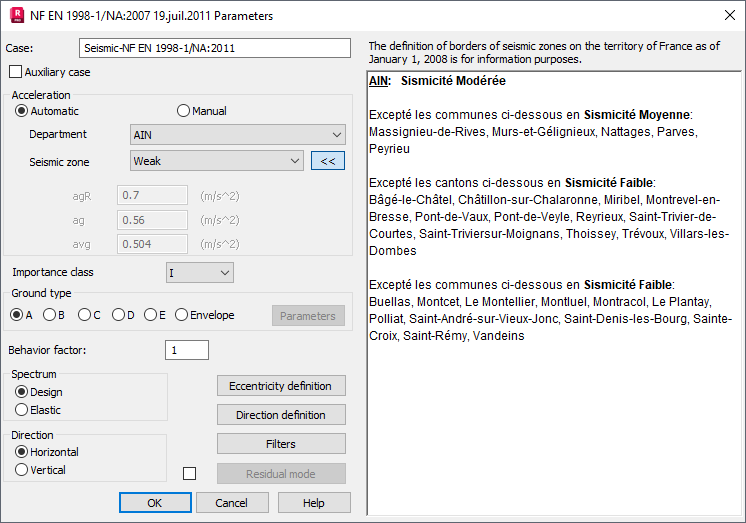
After you select this code, generation of seismic loads is based on the provisional requirements of the NF EN 1998-1/NA:2010p code, not yet released.
To complete the seismic analysis according to the rules given in this code, define the following parameters.
-
Reference peak ground acceleration on type A ground agR. It defines values of the reference acceleration for the horizontal excitation spectrum agr and vertical excitation spectrum a gv. The design ground acceleration ag is defined in terms of the reference peak ground acceleration on type A ground agR and the importance factor γ derived from the building class:
ag = γ × agR.According to the code, there are 5 seismic zones:
Seismic area
Seismic zone
agrm/s2
agvm/s2
1
Very weak
0.0
0.0
2
Weak
0.7
0.45 × agr
3
Moderate
1.1
0.45 × agr
4
Mean
1.6
0.45 × agr
5
Strong
3
0.90 × agr
After selecting the Automatic option, you can define values of the reference acceleration automatically by specifying a department and a seismic zone. Click >> to extend the list of zones for a selected department. The definition of borders of seismic zones on the territory of France as of January 1, 2008 is only for information purposes.
After selecting the Manual option, you can specify your own values of the reference acceleration.
- Importance class (I, II, III, IV) - It specifies the importance factor γ.
Building class
Importance factor γ
I
0.8
II
1.0
III
1.2
IV
1.4
- Ground type (A, B, C, D, E) - It specifies the influence of parameters describing the response spectrum.
Table: Parameters of horizontal spectrum determined by the ground type and seismic zone.
Ground type
Seismic zone 1 to 4
Seismic zone 5
S
TB(s)
TC(s)
TD(s)
S
TB(s)
TC(s)
TD(s)
A
1.00
0.03
0.20
2.50
1.00
0.15
0.40
2.00
B
1.35
0.05
0.25
2.50
1.20
0.15
0.50
2.00
C
1.50
0.06
0.40
2.00
1.15
0.20
0.60
2.00
D
1.60
0.10
0.60
1.50
1.35
0.20
0.80
2.00
E
1.80
0.08
0.45
1.25
1.40
0.15
0.50
2.00
Table: Parameters of the vertical spectrum determined by a seismic zone.
Seismic zone
avg/ag
TB(s)
TC(s)
TD(s)
1 to 4
0.45
0.05
0.15
1.0
5
0.90
0.05
0.15
1.0
If the Envelope option is selected, the Parameters button becomes accessible; click it to open the Spectrum Envelope dialog.
- Value of the
Behavior factor q. According to the main code EN 1998 point 3.2.2.5, this is a reduction factor of the design response spectrum in relation to the elastic response spectrum. You can edit its value after selecting the Design spectrum option.
Note: The behavior factor q reduces the design spectrum; this way it also decreases seismic loads and the resulting internal forces. However, as specified in EN 1998 point 3.2.2.5, the displacement based on the design response spectrum is multiplied by the behavior factor q. Thus, usually such displacement is not reduced in relation to the elastic response spectrum.
-
Spectrum type
(Design or Elastic), as specified in the main code EN 1998 point 3.2.2.
The response spectrum is calculated based on the above parameters using formulas for the elastic response spectrum (points 3.2.2.2 and 3.2.2.3) and for the design spectrum for elastic analysis (point 3.2.2.5).
- Direction (horizontal, vertical).
Click Eccentricity Definition to open the Definition of mass eccentricities dialog where you can specify how to account for the eccentricity of a mass in the seismic analysis
Below in the dialog, the Direction definition, Filters, and Residual Mode buttons are located.
The details concerning this structure analysis method can be found in the mentioned code.
